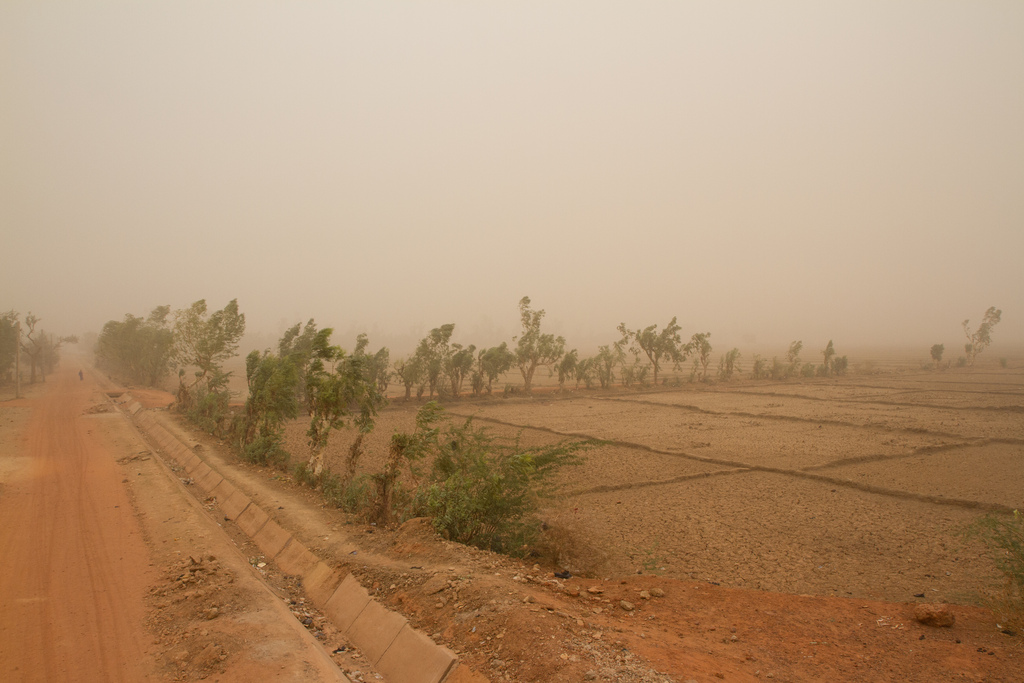Scientists develop climate forecast model for meningitis
Note: Reprinted with permission. Copyright 2014 E&E Publishing, LLC. www.eenews.net/cw
by Umair Irfan, E&E reporter
The Harmattan, a dark, dusty northeasterly trade wind, dims the winter skies over West Africa and sows a deadly plague in its wake. The affliction, meningitis, can infect up to 200,000 people annually across the Sahel, but with regional climate models, health officials are hoping to forecast and push back against this deadly disease.

Dusty wind at the height of the dry season in Naimey, Niger. Francesco Fiondella/IRI
Bacterial meningitis, also called meningococcal disease, is the main epidemic form of the illness in the Sahel, spreading between people in the dry season. In a study published this week in the journal Environmental Health Perspectives, researchers found that in Niger, dust, climate and early-season infection conditions could forecast seasonal outbreaks.
Looking at meningitis records from 38 districts in Niger between 1986 and 2006, the scientists traced how the disease rose and fell based on local climate and dust conditions. The team found that the epidemic peaks between February and March, but the number of cases earlier in the season tended to signal how high the infection rate was going to get. Climate and dust conditions in the preceding November and December were also meningitis harbingers at the district level.
However, researchers are still unsure about how these environmental factors influence meningitis. “Now we have an association of climate parameters with the disease, but we don’t have mechanisms for why that is happening,” said Carlos Pérez Garcïa-Pando, a co-author and a research scientist at the NASA Goddard Institute for Space Studies.
Unlike malaria, which surges around periods of rainfall, meningitis spreads during the dry season. Since people transmit the infection directly through contact or airborne bodily fluids, social factors, such as how people share food, bedding and living spaces, play a major role.
Tougher to track than malaria
“We know much better the mechanism [for malaria] because we have a vector,” said Pérez García-Pando. “With person- to-person contact, it’s more difficult.” He noted that many people transmit the disease without showing any symptoms, making it harder to track, and immunity rates are different among different population subsets.
One hypothesis is that the dust whipped up by the Harmattan may sensitize people to meningitis. Dust particles, particularly iron in soil, can trigger a response in human airways that makes it easier for meningococcal disease to take root, damaging the upper respiratory tract or fostering bacterial growth.
However, validating this idea is tricky. “One of the things you have to do is investigate what’s happening with people’s noses and throats,” said Madeleine Thomson, another co-author and a senior research scientist at the International Research Institute for Climate and Society at Columbia University’s Earth Institute.
With limited public health resources, this is difficult, especially teasing out who is vulnerable when so many people face to the same conditions. “When you get off the plane in Niger, you feel as though you stepped in front of a very hot, dusty hair dryer,” she added.
Nonetheless, researchers said that they could still take steps to fight the disease even if they aren’t fully clear on its workings. The main strategy for fighting meningitis is to use vaccines. The meningococcal polysaccharide vaccine targets all serotypes of the disease, but only confers two to three years of immunity.
Rather than give everyone an injection repeatedly, health officials respond to infection spikes as they occur. There are two main decision thresholds, Thomson explained. The first is a national alert before the meningitis season emerges, encouraging officials to check their vaccine stocks. The second is the epidemic response, in which health workers go to afflicted regions and administer vaccines.
Seeking epidemic signs from climate models
“What we hope the forecasting can do is go from an alert threshold into an epidemic threshold,” Thomson said. “If [health officials] know that the environment is indicative of the epidemic, they can start interventions sooner.”
The tailored response is crucial because many of the regions suffering from seasonal meningitis have limited resources. Responding to epidemics draws money, hardware and personnel away from other health problems. “Meningitis is not the only problem in Africa,” said Pérez García-Pando. “Resources have to be managed in a very efficient way.”
The disease also has political implications, since countries enduring epidemics often face travel bans, Thomson obs erved.
Another type of vaccine, MenAfriVac, confers up to a decade’s worth of immunity, but only to the most common serotype of the pathogen and not the other varieties. Some countries are now deploying this as a preventive measure, but have to balance whether to place their bets on limited long-term immunity versus more comprehensive short-term immunity.
The introduction of this new vaccine could change the calculus for meningitis forecasting. “The dataset [in this study] stopped in 2006. However a preventive vaccination campaign against meningitis serogroup A with MenAfriVac has been done in 2010 in Niger,” said Benjamin Sultan, a researcher at the Pierre and Marie Curie University in France who was not involved in this report but has studied the links between climate and meningitis in Africa.
“It has considerably reduced the number of cases of the disease since 2010 with less than one hundred cases per year. So their model does not work after 2010 and needs to be amended to take into account effects of prevention against the disease,” he said in an email.
The researchers said they now want to develop climate and disease models that are usable in the real world. They also suggested laboratory study using animal models to sort out the mechanism behind meningitis epidemics.

You must be logged in to post a comment.